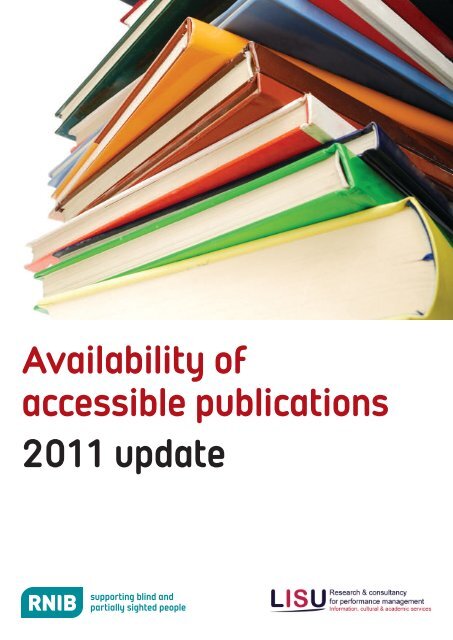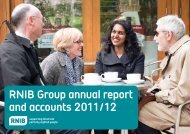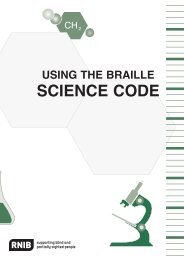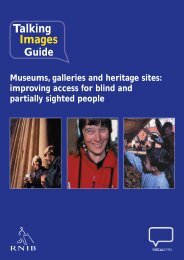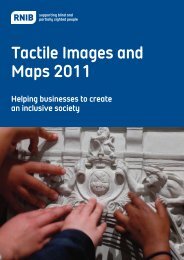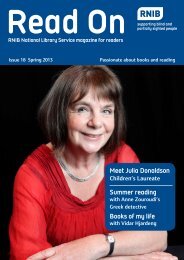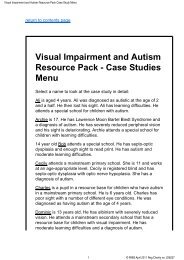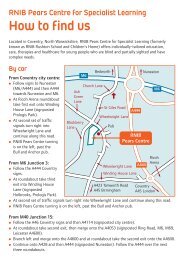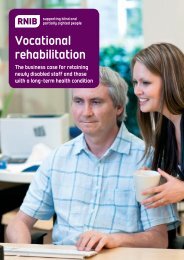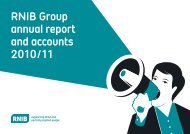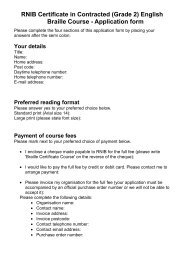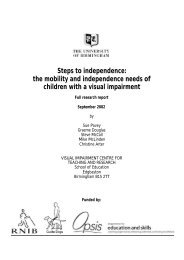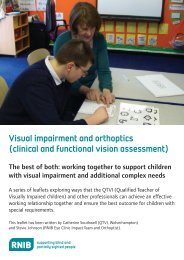Availability of accessible publications 2011 update - RNIB
Availability of accessible publications 2011 update - RNIB
Availability of accessible publications 2011 update - RNIB
You also want an ePaper? Increase the reach of your titles
YUMPU automatically turns print PDFs into web optimized ePapers that Google loves.
<strong>Availability</strong> <strong>of</strong><br />
<strong>accessible</strong> <strong>publications</strong><br />
<strong>2011</strong> <strong>update</strong>
Contents<br />
Executive summary ...................................................................................ii <br />
1 Introduction ......................................................................................1 <br />
1.1 Introduction to methodology .................................................2 <br />
1.2 A note on eBooks .................................................................3 <br />
2 Summary <strong>of</strong> key results ...................................................................5 <br />
2.1 Braille ....................................................................................8 <br />
2.2 Large print.............................................................................9 <br />
2.3 Audio.....................................................................................9 <br />
2.4 Accessible eBooks ...............................................................9 <br />
3 Detailed results ..............................................................................11 <br />
3.1 Fully <strong>accessible</strong> editions.....................................................11 <br />
3.2 Editions <strong>accessible</strong> in any format .......................................12 <br />
3.3 Hard copy braille editions ...................................................15 <br />
3.4 Hard copy large print editions.............................................17 <br />
3.5 Human speech audio editions ............................................19 <br />
3.6 Accessible eBooks .............................................................21 <br />
Appendix A: Methodology .......................................................................23 <br />
<br />
<br />
<br />
i
Executive summary<br />
Background<br />
Whether studying for an exam, keeping pr<strong>of</strong>essional skills up to date,<br />
learning a new recipe, or relaxing with a good read, books are essential<br />
to our education, work and leisure.<br />
However, blind and partially sighted readers face a dramatically limited<br />
choice <strong>of</strong> titles. The number <strong>of</strong> <strong>accessible</strong> titles - by which we mean<br />
books that are available in the three key formats <strong>of</strong> large print, braille<br />
and unabridged audio - is still unacceptably low in comparison to the<br />
range that sighted people enjoy.<br />
<strong>RNIB</strong> believes that blind and partially sighted people have the same<br />
rights to access the rich world <strong>of</strong> books as anyone else. We are<br />
committed members <strong>of</strong> the Right to Read Alliance, which seeks to<br />
ensure that everyone can read the "same book, the same time, at the<br />
same price". <strong>RNIB</strong> has been working hard with key industry partners to<br />
make this a reality and we wanted to understand how far we had<br />
progressed towards reaching this objective.<br />
We commissioned two new pieces <strong>of</strong> research from LISU, a research<br />
and consultancy unit at Loughborough University. The first provides us<br />
with the big picture. Based on titles published between 2006 and 2010,<br />
our "<strong>Availability</strong> <strong>of</strong> <strong>accessible</strong> <strong>publications</strong>: <strong>2011</strong> <strong>update</strong>" aims to provide<br />
an up-to-date estimate <strong>of</strong> the availability <strong>of</strong> <strong>accessible</strong> <strong>publications</strong>. It<br />
also aims to assess the impact <strong>of</strong> <strong>accessible</strong> eBooks and ereaders since<br />
2004, when this study was last completed.<br />
An eBook is a book in an electronic text format. It can, depending on the<br />
eBook and device used, be read as electronic large print, audio (using a<br />
synthetic voice), or braille using an electronic braille display. There are<br />
exciting developments in the digital world, and we have set ourselves an<br />
ambitious strategic target:<br />
"By 2014, blind and partially sighted people are able to read<br />
the 1,000 most popular books each year, using commercial<br />
audio books or eBooks."<br />
ii
The second report, "Accessibility <strong>of</strong> top 1000 titles <strong>of</strong> 2010", shows how<br />
we're doing against our strategic aim to make the most popular titles<br />
<strong>accessible</strong>. It also shows what impact <strong>accessible</strong> eBooks and ereaders<br />
have made since the study was first completed in 2009.<br />
We're aware that one thousand titles remains a small number compared<br />
to the stock <strong>of</strong> a bookshop or library. However, the improving availability<br />
for this most popular range <strong>of</strong> titles shows what is possible. <strong>RNIB</strong> needs<br />
to know where the gaps are, so that we can plan future work to increase<br />
the range <strong>of</strong> <strong>accessible</strong> titles.<br />
Our definition <strong>of</strong> <strong>accessible</strong> books rests on readers' preferred format.<br />
Large print is not an <strong>accessible</strong> format to someone with no useful sight;<br />
braille is not <strong>accessible</strong> to someone who cannot read it. We found it<br />
useful to break down titles by format to help us understand the bigger<br />
picture. However, we only defined books as fully <strong>accessible</strong> if they were<br />
available in the three key formats <strong>of</strong> large print, braille and unabridged<br />
audio, to reflect the diverse and individual needs <strong>of</strong> blind and partially<br />
sighted readers.<br />
Summary <strong>of</strong> key results<br />
Many people who have lost their sight still can't read in formats that are<br />
<strong>accessible</strong> to them, even when including those who use eBooks. We<br />
have a long way to go before blind and partially sighted people can read<br />
the full range <strong>of</strong> books that everybody else takes for granted.<br />
• Just 7 per cent <strong>of</strong> all books are available in braille, audio and large<br />
print, including titles available in these formats using eBooks<br />
However, UK publishers and the eBook industry have worked with <strong>RNIB</strong><br />
to make progress in recent years, especially with recent popular titles<br />
and when including <strong>accessible</strong> eBooks.<br />
• In 2010, 54 per cent <strong>of</strong> the top 1,000 titles were available in braille,<br />
audio and large print, including titles available in these formats using<br />
eBooks<br />
In recent years eBooks have revolutionised the publishing sector. Where<br />
publishers and the eBook industry have incorporated accessibility in<br />
iii
their design, they increase the choice <strong>of</strong> titles for blind and partially<br />
sighted people. We are working hard to open up these new technologies<br />
to more people so that the progress we have made can be enjoyed more<br />
widely.<br />
Starting with the most popular books, but with a strong sense <strong>of</strong> the<br />
bigger picture, we are committed to changing this. It is not acceptable in<br />
our information rich and technology driven age that just seven per cent<br />
<strong>of</strong> books are fully <strong>accessible</strong> to blind and partially sighted people -<br />
especially as many don't currently use eBooks. People who have lost<br />
their sight should be able to choose from a greater selection than this,<br />
like anyone else can. However, by working constructively with<br />
publishers, the eBook industry and blind and partially sighted readers,<br />
we will open up a new world <strong>of</strong> books for all to enjoy.<br />
The full reports<br />
Accessible Publications <strong>2011</strong><br />
This report is available from 24 October <strong>2011</strong> at<br />
rnib.org.uk/<strong>accessible</strong>publishing or by emailing<br />
ebooks@rnib.org.uk to request a copy.<br />
Accessibility <strong>of</strong> top 1,000 titles <strong>of</strong> 2010<br />
This report is available from 10 October <strong>2011</strong> at<br />
rnib.org.uk/<strong>accessible</strong>publishing or by emailing<br />
ebooks@rnib.org.uk to request a copy.<br />
iv
Acknowledgements<br />
The authors would like to thank the following individuals who helped with<br />
this research:<br />
• Sylvie Barr and Donna Tipping, and their colleagues at <strong>RNIB</strong>, for<br />
their helpful comments<br />
• Claire Hazlehurst, Jonathan Pimperton and Rebecca Redfern,<br />
who undertook much <strong>of</strong> the detailed data collection<br />
• Marion Ripley <strong>of</strong> ClearVision<br />
• Brenda Young <strong>of</strong> the British Library<br />
v
1 Introduction<br />
The Royal National Institute <strong>of</strong> Blind People (<strong>RNIB</strong>) has commissioned<br />
LISU at Loughborough University to develop reliable estimates <strong>of</strong> the<br />
availability <strong>of</strong> books in formats <strong>accessible</strong> to people with sight loss,<br />
based on titles published between 2006 and 2010. This report describes<br />
the findings <strong>of</strong> this research, and draws comparisons with earlier <strong>RNIB</strong><br />
studies which also focus on <strong>accessible</strong> <strong>publications</strong>. In particular, it<br />
<strong>update</strong>s the report <strong>of</strong> a similar study published in 2004, and assesses<br />
the impact <strong>of</strong> the advent <strong>of</strong> <strong>accessible</strong> eBooks 1 and eBook readers since<br />
that study. Comparisons are also made with recent LISU analyses <strong>of</strong> the<br />
availability in <strong>accessible</strong> formats <strong>of</strong> the most popular 1,000 titles <strong>of</strong> 2010.<br />
Key similarities and differences between this study and earlier work are<br />
summarised in Table 1a below:<br />
<br />
1<br />
An eBook is ‘an electronic version <strong>of</strong> a printed book that can be read<br />
on a computer or handheld device designed specifically for this<br />
purpose’. www.oxforddictionaries.com (accessed 14/09/11)<br />
1
Table 1a<br />
Key similarities and differences between this study and<br />
earlier work<br />
<strong>Availability</strong> <strong>of</strong><br />
<strong>accessible</strong><br />
<strong>publications</strong>:<br />
<strong>2011</strong> <strong>update</strong><br />
<strong>Availability</strong> <strong>of</strong><br />
<strong>accessible</strong><br />
<strong>publications</strong> 2004<br />
Accessibility <strong>of</strong><br />
top 1,000 titles <strong>of</strong><br />
2010<br />
Period covered<br />
Titles covered<br />
Books published<br />
2006–2010<br />
Random sample<br />
<strong>of</strong> 400 titles for<br />
each <strong>of</strong> the five<br />
years<br />
Books published<br />
1999–2003<br />
Systematic<br />
random sample<br />
<strong>of</strong> circa 400 titles<br />
for each <strong>of</strong> the<br />
five years<br />
The most popular<br />
1,000 titles <strong>of</strong><br />
2010 by preferred<br />
genre <strong>of</strong> sighted<br />
people aged 65<br />
and over<br />
Total titles 2,000 2,069 1,000<br />
Formats<br />
considered<br />
Hard copy braille,<br />
hard copy large<br />
print, human<br />
voice audio,<br />
<strong>accessible</strong><br />
eBooks<br />
Hard copy braille,<br />
hard copy large<br />
print, human<br />
voice audio,<br />
Moon, electronic<br />
text files<br />
Hard copy braille,<br />
hard copy large<br />
print, human<br />
voice audio,<br />
<strong>accessible</strong><br />
eBooks<br />
Purpose <strong>of</strong><br />
commissioning<br />
<br />
To indicate day to day experience <strong>of</strong><br />
blind and partially sighted people<br />
To ascertain<br />
progress against<br />
<strong>RNIB</strong> strategic<br />
goal<br />
1.1 Introduction to methodology<br />
A random selection <strong>of</strong> 400 titles included in the British National<br />
Bibliography (BNB) for each <strong>of</strong> the five years from 2006 to 2010 was<br />
supplied by the British Library, giving an overall sample <strong>of</strong> 2,000 titles.<br />
The analysis <strong>of</strong> these titles therefore provides unbiased estimates <strong>of</strong> the<br />
availability <strong>of</strong> <strong>accessible</strong> formats for all books published in the UK over<br />
the period. The formats considered were unabridged audio (that is, an<br />
audio edition <strong>of</strong> the full work, as opposed to abridged audio, which is a<br />
shortened version <strong>of</strong> the original work), braille and large print (that is,<br />
with a font <strong>of</strong> 16 point or higher), and the approach taken is described in<br />
2
detail in Appendix A. The research was undertaken during July and<br />
August <strong>2011</strong>.<br />
Books were considered to be fully <strong>accessible</strong> only if they were found to<br />
be available in all three formats <strong>of</strong> unabridged audio, braille and large<br />
print. Priority was given to commercial provision. Charitable providers<br />
were also included, but <strong>accessible</strong> books that are available commercially<br />
were considered first and foremost, as this provision is crucial to <strong>RNIB</strong>'s<br />
aim <strong>of</strong> equitable access for blind and partially sighted people. The aim<br />
was to identify one edition <strong>of</strong> each title in large print, audio and braille<br />
formats, where available; in practice the format <strong>of</strong> the databases used,<br />
and their search interfaces, were such that multiple editions were <strong>of</strong>ten<br />
identified. Where this was the case, all editions identified were recorded.<br />
However, the researchers did not undertake a comprehensive search for<br />
all possible editions for each <strong>accessible</strong> format <strong>of</strong> each title; once one<br />
had been found no further sources were searched for that format. For<br />
eBooks, only Apple iBooks were regarded as fully <strong>accessible</strong>, while<br />
books for the Kindle ereader were included as <strong>accessible</strong> in large print.<br />
To enable comparison <strong>of</strong> the latest results with those from the 2004<br />
work, the earlier data were re-analysed in line with the current definitions<br />
<strong>of</strong> accessibility. Formats such as Moon, and electronic text files, which<br />
were included in the 2004 study, do not meet current <strong>RNIB</strong> accessibility<br />
criteria, and were not included in the data analysis for this report. Hence,<br />
percentages presented here for 2004 may differ slightly from those<br />
originally reported. Further details are given in Appendix A.<br />
Percentages presented in this report for the <strong>2011</strong> and 2004 studies are<br />
given to two decimal places. Comparable proportions for the top 1,000 <strong>of</strong><br />
2010 are given to one decimal place, as the second decimal place would<br />
be zero in all cases.<br />
In <strong>2011</strong> the databases available for identifying <strong>accessible</strong> formats were<br />
somewhat different from those in 2004. Details are given in Appendix A.<br />
1.2 A note on eBooks<br />
eBooks will be read on a variety <strong>of</strong> different devices with different<br />
capabilities. <strong>RNIB</strong> criteria for inclusion as <strong>accessible</strong> eBooks are<br />
3
intended to reflect the ways that eBooks can be read by blind and<br />
partially sighted people in <strong>2011</strong>:<br />
• For large print, an eBook must be capable <strong>of</strong> being read without third<br />
party access technology such as screen magnification s<strong>of</strong>tware or a<br />
video magnifier.<br />
• For synthetic speech audio, an eBook solution should not require<br />
sighted assistance to choose the book to be read, and should enable<br />
a reader to navigate within the book independently.<br />
• To qualify as <strong>accessible</strong> for electronic braille users, an eBook must<br />
be capable <strong>of</strong> being read with an electronic braille display, allowing a<br />
similar degree <strong>of</strong> independence to synthetic speech.<br />
In <strong>2011</strong>, Apple iBooks via Apple devices met all <strong>of</strong> these criteria, while<br />
Kindle eBooks only met the criteria for large print. This was also true <strong>of</strong><br />
the 2010 Top 1,000 study: eBooks were not included in 2004, although<br />
the availability <strong>of</strong> texts in electronic formats was recorded.<br />
4
2 Summary <strong>of</strong> key results<br />
• In total, just 0.25 per cent <strong>of</strong> titles were fully <strong>accessible</strong> in ‘traditional’<br />
formats (hard copy braille, hard copy large print, human voice audio)<br />
in <strong>2011</strong>. This compares to 0.39 per cent <strong>of</strong> titles in the 2004 study,<br />
and 14.7 per cent <strong>of</strong> the top 1,000 titles <strong>of</strong> 2010 2 . This is illustrated in<br />
Figure 2a.<br />
Figure 2a Percentage <strong>of</strong> fully <strong>accessible</strong> books<br />
<strong>2011</strong><br />
2004<br />
Top 1,000<br />
2010<br />
0% 5% 10% 15%<br />
• When <strong>accessible</strong> eBooks are included, there is a significant<br />
improvement in accessibility. People who are blind or partially<br />
sighted can access 6.80 per cent <strong>of</strong> titles in all three formats (braille,<br />
audio and large print) including electronic editions in <strong>2011</strong>. This<br />
compares to 54.4 per cent <strong>of</strong> the top 1,000 titles <strong>of</strong> 2010. This is<br />
illustrated in Figure 2b.<br />
<br />
2<br />
Percentages presented in this report for the <strong>2011</strong> and 2004 studies<br />
are given to two decimal places. Comparable proportions for the top<br />
1,000 <strong>of</strong> 2010 are given to one decimal place, as the second decimal<br />
place would be zero in all cases.<br />
5
Figure 2b Percentage <strong>of</strong> fully <strong>accessible</strong> books<br />
(including eBooks)<br />
<strong>2011</strong><br />
Top 1,000 in<br />
2010<br />
0% 10% 20% 30% 40% 50% 60%<br />
• When the availability <strong>of</strong> any traditional <strong>accessible</strong> format is<br />
considered, people with sight loss have access to 6.05 per cent <strong>of</strong><br />
titles, a statistically significantly 3 higher proportion than in 2004, when<br />
4.59 per cent <strong>of</strong> titles were available 4 . The equivalent figure for the<br />
2010 top 1,000 books is 62.6 per cent. This is illustrated in Figure 2c.<br />
<br />
3<br />
The statistical significance <strong>of</strong> a result is the probability (p-value) that<br />
the result observed in a sample occurred by pure chance, and that in<br />
the population from which the sample was drawn, no such<br />
relationship or differences exist. The smaller the p-value, the more<br />
likely is the result to be ‘true’ for the population as a whole. In this<br />
report, results have been described as statistically significant when<br />
the p-value is less than 5 per cent (p
Figure 2c Percentage <strong>of</strong> books available in any traditional<br />
<strong>accessible</strong> format<br />
<strong>2011</strong><br />
2004<br />
Top 1,000 in 2010<br />
0% 10% 20% 30% 40% 50% 60% 70%<br />
• When <strong>accessible</strong> eBooks are included, the availability <strong>of</strong> titles in any<br />
<strong>accessible</strong> formats improves, to 19.70 per cent <strong>of</strong> the titles. This<br />
compares to 80.4 per cent <strong>of</strong> the top 1,000 titles <strong>of</strong> 2010. This is<br />
illustrated in Figure 2d.<br />
Figure 2d Percentage <strong>of</strong> books available in any <strong>accessible</strong><br />
format (including eBooks)<br />
<strong>2011</strong><br />
Top 1,000<br />
2010<br />
0% 20% 40% 60% 80% 100%<br />
• Looking at each format individually, 1.25 per cent <strong>of</strong> the titles<br />
considered in <strong>2011</strong> are available in hard copy braille, 3.65 per cent<br />
are available in hard copy large print and 3.50 per cent are available<br />
in one or more formats <strong>of</strong> unabridged human voice audio. This is<br />
illustrated in Figure 2e.<br />
7
• When <strong>accessible</strong> eBooks are included, 7.35 per cent <strong>of</strong> titles are<br />
<strong>accessible</strong> in one or more formats <strong>of</strong> braille, 18.45 per cent are<br />
<strong>accessible</strong> as large print and 8.60 per cent <strong>accessible</strong> as unabridged<br />
audio. This is also illustrated in Figure 2e.<br />
Figure 2e Percentage <strong>of</strong> books available in braille, audio and<br />
large print formats, excluding and including eBooks<br />
20%<br />
15%<br />
10%<br />
5%<br />
Hard copy<br />
Including<br />
eBooks<br />
0%<br />
Braille Audio Large print<br />
• It is clear from comparison <strong>of</strong> the <strong>2011</strong> results with those from the top<br />
1,000 <strong>of</strong> 2010 study that more popular titles are more likely to be fully<br />
<strong>accessible</strong> than the average <strong>of</strong> all titles.<br />
2.1 Braille<br />
• Overall, blind and partially sighted readers are able to access 1.25<br />
per cent <strong>of</strong> titles examined in <strong>2011</strong> in one or more hard copy braille<br />
formats. This compares to 1.93 per cent in the 2004 study and 27.8<br />
per cent <strong>of</strong> the top 1,000 titles <strong>of</strong> 2010.<br />
• Only 1.10 per cent <strong>of</strong> titles were available for loan via <strong>RNIB</strong> or<br />
ClearVision in <strong>2011</strong>, compared to 27.2 per cent <strong>of</strong> the top 1,000 titles<br />
<strong>of</strong> 2010. The 2004 study did not distinguish between titles for sale<br />
and those for loan.<br />
• Readers who have lost their sight were able to purchase 0.70 per<br />
cent <strong>of</strong> titles in the <strong>2011</strong> study in hard copy braille formats –<br />
compared to 25.7 per cent <strong>of</strong> the top 1,000 titles <strong>of</strong> 2010.<br />
• eBooks have a considerable impact on improving accessibility,<br />
increasing the proportion <strong>of</strong> titles available in one or more braille<br />
formats to 7.35 per cent. This compares to 57.8 per cent <strong>of</strong> the top<br />
1,000 titles <strong>of</strong> 2010.<br />
8
2.2 Large print<br />
• Overall, blind and partially sighted readers could access 3.65 per<br />
cent <strong>of</strong> titles in the <strong>2011</strong> study in hard copy large print, compared to<br />
1.50 per cent <strong>of</strong> titles in the 2004 study and 40.6 per cent <strong>of</strong> the top<br />
1,000 titles <strong>of</strong> 2010.<br />
• Including <strong>accessible</strong> eBooks (Apple iBooks and Kindle eBooks for<br />
large print) results in a significant increase in availability, with 18.45<br />
per cent <strong>of</strong> titles being <strong>accessible</strong> in large print including eBooks.<br />
This compares to 75.7 per cent <strong>of</strong> the top 1,000 titles <strong>of</strong> 2010.<br />
2.3 Audio<br />
• Overall, blind and partially sighted readers could access 3.50 per<br />
cent <strong>of</strong> the titles included in the <strong>2011</strong> study in one or more<br />
unabridged human voice audio formats; this figure is unchanged<br />
since the 2004 study. 47.7 per cent <strong>of</strong> the top 1,000 titles <strong>of</strong> 2010<br />
were <strong>accessible</strong> as human voice unabridged audio.<br />
• CDs were the most frequently identified human voice unabridged<br />
audio format, with 1.75 per cent <strong>of</strong> all titles available in this format –<br />
compared to 0.29 per cent in 2004. 27.2 per cent <strong>of</strong> the top 1,000<br />
titles <strong>of</strong> 2010 were <strong>accessible</strong> as human voice CDs. Just 0.50 per<br />
cent <strong>of</strong> the titles in the <strong>2011</strong> research were available commercially for<br />
download, compared to 12.8 per cent <strong>of</strong> the top 1,000 titles <strong>of</strong> 2010.<br />
• DAISY talking books were available from <strong>RNIB</strong> for 0.95 per cent <strong>of</strong><br />
titles, including 0.45 per cent <strong>of</strong> titles which were not available in any<br />
commercial human voice audio format.<br />
• Including synthetic speech via <strong>accessible</strong> eBooks results in readers<br />
with sight loss being able to access 8.60 per cent <strong>of</strong> titles in<br />
unabridged audio, compared to 69.1 per cent <strong>of</strong> the top 1,000 titles <strong>of</strong><br />
2010.<br />
2.4 Accessible eBooks<br />
• Overall, 6.65 per cent <strong>of</strong> titles were available as fully <strong>accessible</strong><br />
eBooks – compared to 44.6 per cent <strong>of</strong> the top 1,000 titles <strong>of</strong> 2010.<br />
• A further 9.65 per cent <strong>of</strong> titles were available as eBooks <strong>accessible</strong><br />
in electronic large print.<br />
9
• 4.50 per cent <strong>of</strong> titles included in the <strong>2011</strong> study were fully <strong>accessible</strong><br />
only as Apple iBooks – that is, they were not available in all three<br />
formats <strong>of</strong> hard copy braille, human speech audio and hard copy<br />
large print (although some were available in one or two <strong>of</strong> those<br />
formats).<br />
• 13.60 per cent <strong>of</strong> titles were only <strong>accessible</strong> to readers with sight loss<br />
in any format as eBooks – with 90 <strong>of</strong> these (4.50 per cent <strong>of</strong> the total)<br />
only <strong>accessible</strong> as Apple iBooks, and a further 182 (9.10 per cent <strong>of</strong><br />
the total) available as Kindle eBooks. By comparison, 11.7 per cent<br />
<strong>of</strong> the top 1,000 titles <strong>of</strong> 2010 were available to readers with sight<br />
loss only as Apple ibooks, with a further 6.10 per cent <strong>of</strong> titles only<br />
available as Kindle eBooks (that is, there were no hard copy<br />
<strong>accessible</strong> formats available for these titles).<br />
10
3 Detailed results<br />
3.1 Fully <strong>accessible</strong> editions<br />
3.1.1 Traditional formats<br />
Titles were considered to be fully <strong>accessible</strong> if they were available in all<br />
three formats <strong>of</strong> unabridged human voice audio, hard copy braille and<br />
hard copy large print, from any source. Of the sample titles selected for<br />
<strong>2011</strong>, just 0.25 per cent <strong>of</strong> titles were fully <strong>accessible</strong> 5 . In the 2004 study,<br />
0.39 per cent titles were found to be fully <strong>accessible</strong>; this apparent fall in<br />
the proportion <strong>of</strong> fully <strong>accessible</strong> books is not statistically significant,<br />
however. By comparison, 14.7 per cent <strong>of</strong> the top 1,000 titles <strong>of</strong> 2010<br />
were found to be fully <strong>accessible</strong>.<br />
3.1.2 Accessible eBooks<br />
Including <strong>accessible</strong> eBooks in the relevant categories results in readers<br />
who have lost their sight being able to obtain 6.80 per cent <strong>of</strong> fully<br />
<strong>accessible</strong> titles in <strong>2011</strong> 6 . By comparison, the inclusion <strong>of</strong> <strong>accessible</strong><br />
eBooks meant that 54.4 per cent <strong>of</strong> the top 1,000 titles <strong>of</strong> 2010 were fully<br />
<strong>accessible</strong> to people with sight loss.<br />
3.1.3 Analysis by year <strong>of</strong> publication<br />
Considering each <strong>of</strong> the years from 2006–2010 individually, the number<br />
<strong>of</strong> titles that are fully <strong>accessible</strong> in traditional formats is relatively low in<br />
each year. However, it should be noted that alternative formats <strong>of</strong> a title<br />
may not be produced at the same time as the initial publication. As a<br />
result, the timing <strong>of</strong> the data collection may have had an impact on the<br />
availability <strong>of</strong> <strong>accessible</strong> formats by year, as a longer time had elapsed<br />
between titles published in the earlier years and the point <strong>of</strong> data<br />
collection, giving more opportunity for traditional alternative formats to<br />
have been produced. None <strong>of</strong> the sample <strong>of</strong> 400 titles for 2010 was<br />
found to be fully <strong>accessible</strong>, compared to 0.50 per cent <strong>of</strong> titles for the<br />
year 2006.<br />
<br />
5<br />
The standard error <strong>of</strong> this estimate is 0.11 per cent, giving a<br />
confidence interval <strong>of</strong> between 0.03 per cent and 0.47 per cent.<br />
6<br />
The standard error <strong>of</strong> this estimate is 0.56 per cent, giving a<br />
confidence interval <strong>of</strong> between 5.70 per cent and 7.90 per cent.<br />
11
The inclusion <strong>of</strong> <strong>accessible</strong> eBooks, however, improves the situation,<br />
although there is no evidence <strong>of</strong> increasing provision over the five-year<br />
period, with 6.00 per cent <strong>of</strong> titles published in both 2006 and 2010<br />
found to be fully <strong>accessible</strong>.<br />
3.2 Editions <strong>accessible</strong> in any format<br />
There has been a slight, but statistically significant 7 , fall in the proportion<br />
<strong>of</strong> titles that cannot be found in any traditional <strong>accessible</strong> format, from<br />
95.41 per cent in 2004 to 93.95 per cent in <strong>2011</strong>. Including <strong>accessible</strong><br />
eBooks makes a considerable impact on the availability <strong>of</strong> <strong>accessible</strong><br />
titles for blind and partially sighted people, although they are still unable<br />
to access 80.25 per cent 8 <strong>of</strong> titles in any <strong>accessible</strong> format.<br />
Overall, for 2006–<strong>2011</strong>, <strong>of</strong> the 6.05 per cent <strong>of</strong> titles available in any <strong>of</strong><br />
the traditional formats:<br />
• 4.13 per cent were available in all three formats<br />
• 30.58 per cent were available in two <strong>of</strong> the three formats<br />
• 65.29 per cent were available in just one <strong>of</strong> the three formats<br />
<br />
By comparison, in 2004, <strong>of</strong> the 4.60 per cent titles available in any <strong>of</strong> the<br />
hard copy/human voice formats:<br />
• 8.42 per cent were available in all three formats<br />
• 26.32 per cent were available in two <strong>of</strong> the three formats<br />
• 65.27 per cent were available in just one <strong>of</strong> the traditional formats<br />
<br />
Table 3a compares the accessibility in the various traditional formats<br />
between <strong>2011</strong>, 2004, and the top 1,000 titles <strong>of</strong> 2010. Table 3b shows<br />
the effect <strong>of</strong> <strong>accessible</strong> eBooks on the <strong>2011</strong> results, and compares this<br />
to the top 1,000 <strong>of</strong> 2010 including <strong>accessible</strong> eBooks.<br />
<br />
7<br />
p
Table 3a<br />
Proportion <strong>of</strong> titles available in each combination <strong>of</strong><br />
formats<br />
<strong>2011</strong><br />
Excluding<br />
eBooks<br />
Top 1000 <strong>of</strong><br />
2010,<br />
excluding<br />
eBooks<br />
2004 results<br />
Braille only 0.45% 3.2% 0.82%<br />
Audio only 1.50% 11.5% 1.59%<br />
Large print only 2.00% 9.1% 0.58%<br />
Braille and audio 0.45% 7.3% 0.68%<br />
Braille and large print 0.10% 2.6% 0.05%<br />
Audio and large print 1.30% 14.2% 0.48%<br />
All three formats 0.25% 14.7% 0.39%<br />
None 93.95% 37.4% 95.40%<br />
<br />
Total titles 2,000 1,000 2,069<br />
There are statistically significant differences between <strong>2011</strong> and 2004 in<br />
the percentages <strong>of</strong> titles available in large print only (p
Table 3b<br />
Proportion <strong>of</strong> titles available in each combination <strong>of</strong><br />
formats<br />
<strong>2011</strong><br />
Excluding<br />
eBooks<br />
<strong>2011</strong><br />
Including<br />
eBooks<br />
Top 1,000<br />
<strong>of</strong> 2010,<br />
including<br />
eBooks<br />
Braille only 0.45% 0.30% 1.1%<br />
Audio only 1.50% 0.80% 2.4%<br />
Large print only 2.00% 10.70% 9.1%<br />
Braille and audio 0.45% 0.15% 1.2%<br />
Braille and large print 0.10% 0.10% 1.1%<br />
Audio and large print 1.30% 0.85% 11.1%<br />
All three formats 0.25% 6.80% 54.4%<br />
None 93.95% 80.25% 19.6%<br />
Total titles 2,000 2,000 1,000<br />
The <strong>2011</strong> study found that readers who had lost their sight were unable<br />
to access 93.95 per cent <strong>of</strong> titles in any hard copy/human voice audio<br />
format – compared to 95.55 per cent <strong>of</strong> titles in 2004. This compares to<br />
37.4 per cent <strong>of</strong> the top 1,000 titles <strong>of</strong> 2010 not <strong>accessible</strong> in any hard<br />
copy format. When <strong>accessible</strong> eBooks are included, the proportion <strong>of</strong><br />
titles not available in any <strong>of</strong> the three formats in <strong>2011</strong> falls to 80.25 per<br />
cent. By comparison, when including <strong>accessible</strong> eBooks, just 19.6 per<br />
cent <strong>of</strong> the top 1,000 titles <strong>of</strong> 2010 were not <strong>accessible</strong> to blind and<br />
partially sighted readers in any format.<br />
The sections which follow give detailed results for each <strong>of</strong> the main<br />
<strong>accessible</strong> formats <strong>of</strong> hard copy braille, hard copy large print and human<br />
voice audio. Accessible eBooks are considered separately. The results<br />
for traditional formats are compared to both the 2004 study, and the data<br />
for the top 1,000 most popular books <strong>of</strong> 2010. Results including<br />
14
<strong>accessible</strong> eBooks are compared with the results for the top 1,000 titles<br />
<strong>of</strong> 2010.<br />
3.3 Hard copy braille editions<br />
All titles were searched on the <strong>RNIB</strong> catalogue <strong>of</strong> books in alternative<br />
formats available from <strong>RNIB</strong> for loan or sale. A list <strong>of</strong> the children's titles<br />
not available from <strong>RNIB</strong> was sent to ClearVision 9 , a UK postal lending<br />
library <strong>of</strong> mainstream children's books with added braille, who checked<br />
their catalogue on our behalf.<br />
There was some overlap, with several titles available in more than one<br />
type <strong>of</strong> braille (such as Grade 1, or uncontracted braille, generally used<br />
by those who are new to braille, and Grade 2, or contracted braille,<br />
which is more popular) or from more than one source. Contracted braille<br />
was the more common format available in all <strong>of</strong> the studies considered<br />
in this report.<br />
Overall, 1.25 per cent <strong>of</strong> titles were available in hard copy braille 10 .<br />
Looking at the different editions available shows that, overall, readers<br />
with sight loss have access to just 0.15 per cent <strong>of</strong> titles to purchase and<br />
0.10 per cent available for loan in Grade 1 braille. 0.70 per cent <strong>of</strong> titles<br />
were available for readers to purchase in Grade 2 braille, with 1.05 per<br />
cent available for loan in this format. Just one further title was available,<br />
for loan, from ClearVision.<br />
Overall, for the period 2006–2010, 0.70 per cent <strong>of</strong> titles were available<br />
for purchase by blind and partially sighted readers, with 1.10 per cent <strong>of</strong><br />
the titles available for loan in one or more braille formats.<br />
There has been an apparent reduction in overall availability from that<br />
found in the 2004 study, when 1.93 per cent <strong>of</strong> titles were available in<br />
hard copy braille formats (including braille with print); however the<br />
difference is not statistically significant. The 2004 study did not<br />
distinguish between titles for loan and for sale.<br />
<br />
9<br />
http://www.clearvisionproject.org/<br />
10<br />
The standard error <strong>of</strong> this estimate is 0.25 per cent, giving a 95 per<br />
cent confidence interval <strong>of</strong> between 0.76 per cent and 1.74 per cent.<br />
15
Overall, 27.8 per cent <strong>of</strong> the top 1,000 titles <strong>of</strong> 2010 were available in<br />
one or more hard copy braille formats. The figure <strong>of</strong> 1.10 per cent in<br />
<strong>2011</strong> compares to 27.2 per cent <strong>of</strong> the top 1,000 titles <strong>of</strong> 2010 available<br />
for loan from <strong>RNIB</strong> or ClearVision. 25.7 per cent <strong>of</strong> the top 1,000 titles<br />
were available for purchase in 2010 (compared to 0.7 per cent in the<br />
latest study).<br />
When eBooks (Apple iBooks) are included, the proportion <strong>of</strong> titles that<br />
blind and partially sighted readers are able to access in one or more<br />
braille formats in <strong>2011</strong> increases to 7.35 per cent 11 . Figure 3c illustrates<br />
the availability <strong>of</strong> braille editions by year <strong>of</strong> publication, and shows the<br />
impact <strong>of</strong> the inclusion <strong>of</strong> <strong>accessible</strong> eBooks. The number <strong>of</strong> titles<br />
identified is also shown, out <strong>of</strong> 400 sampled in each year.<br />
Figure 3c<br />
12%<br />
Accessibility <strong>of</strong> braille editions<br />
Including eBooks<br />
10%<br />
8%<br />
Hard copy<br />
36<br />
6%<br />
20<br />
19<br />
25<br />
22<br />
122<br />
4%<br />
2%<br />
0%<br />
7 6 5 4 3 25<br />
2006 2007 2008 2009 2010 Total<br />
By comparison, the inclusion <strong>of</strong> <strong>accessible</strong> eBooks results in 57.8 per<br />
cent <strong>of</strong> the top 1,000 titles <strong>of</strong> 2010 being <strong>accessible</strong> for readers with<br />
sight loss in one or more <strong>of</strong> the braille formats.<br />
<br />
11<br />
The standard error <strong>of</strong> this estimate is 0.58 per cent, giving a 95 per<br />
cent confidence interval <strong>of</strong> between 6.21 per cent and 8.49 per cent.<br />
16
3.4 Hard copy large print editions<br />
Nielsen BookData was the initial source for identifying commercial hard<br />
copy large print editions. This was supplemented by searches <strong>of</strong> the<br />
British National Bibliography (BNB), which added considerably to the<br />
total. Charitable provision was identified through the <strong>RNIB</strong> catalogue.<br />
This was generally indicated as "Print various sizes at NBCS Custom<br />
Eyes Books". These are titles available to purchase from the National<br />
Blind Children's Society (NBCS), who customise them as required; both<br />
adult and children's titles were available in this format.<br />
There was little duplication between the sources when searching for<br />
large print editions, as the process was more hierarchical. Overall,<br />
readers who have lost their sight were able to access 3.65 per cent <strong>of</strong><br />
titles in hard copy large print 12 .<br />
In total, 3.45 per cent <strong>of</strong> the titles in the <strong>2011</strong> study were available in<br />
large print from commercial sources, with 43 per cent <strong>of</strong> these being<br />
found in the Nielsen Bookdata database, and a further 57 per cent in the<br />
BNB. Just 0.25 per cent <strong>of</strong> titles were available in hard copy large print in<br />
the <strong>RNIB</strong> catalogue; <strong>of</strong> these, all but one were not available from<br />
commercial sources.<br />
There has been a statistically significant 13 improvement over the position<br />
in 2004, when 1.49 per cent <strong>of</strong> titles were found to be available in hard<br />
copy large print, compared to 3.65 per cent in the latest study.<br />
37.6 per cent <strong>of</strong> the top 1,000 titles <strong>of</strong> 2010 were available in hard copy<br />
large print. Once again, this finding underlines that the more popular<br />
titles are more likely to be available in alternative formats.<br />
The inclusion <strong>of</strong> <strong>accessible</strong> eBooks (iBooks and Kindle eBooks)<br />
increases the proportion <strong>of</strong> titles available in large print to 18.5 per cent<br />
in <strong>2011</strong>. Figure 3d displays the proportion <strong>of</strong> titles published in each year<br />
<strong>of</strong> the period 2006–2010 that were found to be <strong>accessible</strong> in large print,<br />
<br />
12<br />
The standard error <strong>of</strong> this estimate is 0.42 per cent, giving a 95 per<br />
cent confidence interval <strong>of</strong> between 2.83 per cent and 4.47 per cent.<br />
13<br />
p
and compares the proportion <strong>of</strong> hard copy large print with the proportion<br />
<strong>of</strong> <strong>accessible</strong> titles in large print when eBooks are included. The<br />
numbers <strong>of</strong> <strong>accessible</strong> titles in each category are also given. The<br />
percentages for each year are based on 400 titles, and for the total<br />
column on the overall total <strong>of</strong> 2,000 titles.<br />
Figure 3d Accessibility <strong>of</strong> large print editions<br />
% <strong>accessible</strong><br />
25%<br />
20%<br />
15%<br />
10%<br />
62<br />
50<br />
62<br />
77<br />
Hard copy<br />
Electronic<br />
45<br />
296<br />
5%<br />
0%<br />
16 18 23 13<br />
3<br />
73<br />
2006 2007 2008 2009 2010 Total<br />
In comparison, a total <strong>of</strong> 75.7 per cent <strong>of</strong> the top 1,000 titles <strong>of</strong> 2010<br />
were available in large print including <strong>accessible</strong> eBooks (iBooks and<br />
Kindle eBooks).<br />
3.4.1 Giant print<br />
In common with the 2004 study, the number <strong>of</strong> titles available in giant<br />
print was noted during the course <strong>of</strong> the data collection. 0.40 per cent <strong>of</strong><br />
titles were found to be available in this format and, <strong>of</strong> these, three<br />
quarters were also available in large print. Owing to the specialist nature<br />
<strong>of</strong> this format in comparison to large print, it has not been included as<br />
contributing to the totals for large print, and no separate analysis has<br />
been included here. In 2004, 0.10 per cent <strong>of</strong> titles were found to be<br />
available in giant print.<br />
18
3.5 Human speech audio editions<br />
Nielsen BookData and Audible.co.uk were searched for commercially<br />
available unabridged audio editions, which were recorded as being<br />
available on CD, on cassette or as downloadable files. In the latest study<br />
(and in the top 1,000 <strong>of</strong> 2010), CDs were found to be available as<br />
traditional CDs or with MP3 format files, which take up less disk space,<br />
and can be played on a wider variety <strong>of</strong> players; these were not noted<br />
separately. Although downloadable unabridged audio books qualify as<br />
<strong>accessible</strong> formats, it must be noted that the process <strong>of</strong> downloading<br />
audio books may not always be fully <strong>accessible</strong> to blind and partially<br />
sighted people, for example, if the download website is not designed in<br />
an <strong>accessible</strong> way or is in<strong>accessible</strong> to assistive technology such as<br />
screen readers.<br />
It was not always clear whether or not recordings were unabridged, even<br />
when the number <strong>of</strong> discs or playing time was given. If there was any<br />
doubt, the title was not considered 'available' from this source.<br />
In detail, the proportions <strong>of</strong> titles found in the various unabridged human<br />
voice audio formats were:<br />
• 1.75 per cent available commercially on CD<br />
• 0.50 per cent available to download commercially<br />
• 1.35 per cent available commercially on cassette<br />
• 0.95 per cent available as DAISY talking books<br />
There was some duplication, with some titles being available in more<br />
than one format. Overall, 3.05 per cent <strong>of</strong> titles were available in one or<br />
more formats commercially, with a total <strong>of</strong> 0.95 per cent <strong>of</strong> titles<br />
available as DAISY talking books, including 0.45 per cent <strong>of</strong> titles not<br />
available elsewhere commercially.<br />
Overall, for the <strong>2011</strong> accessibility <strong>update</strong>, 3.50 per cent <strong>of</strong> titles were<br />
available as unabridged human voice audio recordings 14 .<br />
<br />
14<br />
The standard error for this estimate is 0.41 per cent, giving a 95 per<br />
cent confidence interval <strong>of</strong> between 2.69 per cent and 4.31 per cent.<br />
19
In 2004, 3.14 per cent <strong>of</strong> titles were available in one or more <strong>of</strong> the<br />
human voice audio formats – the slight increase noted in <strong>2011</strong> is not<br />
statistically significant. Just 0.29 per cent <strong>of</strong> titles were available<br />
commercially on CD and 0.77 per cent <strong>of</strong> titles were available as DAISY<br />
talking books from <strong>RNIB</strong>. <strong>Availability</strong> <strong>of</strong> both <strong>of</strong> these formats has<br />
increased in the latest study compared to 2004. Not surprisingly, the<br />
proportion <strong>of</strong> titles available commercially on cassette has decreased<br />
from 2.80 per cent in 2004 to 1.35 per cent in the <strong>2011</strong> study.<br />
Once again, the proportion <strong>of</strong> the top 1,000 titles <strong>of</strong> 2010 that was<br />
available in human voice audio formats was significantly higher, with a<br />
total <strong>of</strong> 47.7 per cent available in one or more <strong>of</strong> these formats in 2010.<br />
Including <strong>accessible</strong> eBooks (Apple iBooks) increases the number <strong>of</strong><br />
human voice audio titles available to blind and partially sighted readers<br />
to 8.60 per cent <strong>of</strong> titles overall 15 . By comparison, 69.1 per cent <strong>of</strong> the<br />
top 1,000 titles <strong>of</strong> 2010 were found to be <strong>accessible</strong> in audio format,<br />
when <strong>accessible</strong> eBooks were included.<br />
Figure 3e illustrates the proportion <strong>of</strong> human voice audio titles available<br />
in each year <strong>of</strong> the 2004 and <strong>2011</strong> studies, both in human voice format<br />
only and (for <strong>2011</strong>) including eBooks. <strong>Availability</strong> <strong>of</strong> human voice<br />
editions has fluctuated over the period, with no apparent trend emerging.<br />
<br />
15<br />
The standard error <strong>of</strong> this estimate is 0.63 per cent, giving a 95 per<br />
cent confidence interval <strong>of</strong> between 7.37 per cent and 9.83 per cent.<br />
20
Figure 3e<br />
<strong>Availability</strong> <strong>of</strong> unabridged audio editions<br />
12%<br />
10%<br />
8%<br />
6%<br />
4%<br />
2%<br />
0%<br />
1999 2000 2001 2002 2003 2006 2007 2008 2009 2010<br />
% <strong>accessible</strong> - human voice<br />
% <strong>accessible</strong> - human voice + eBooks<br />
3.6 Accessible eBooks<br />
Overall, readers with sight loss had access to 16.3 per cent <strong>of</strong> titles via<br />
Amazon Kindle or the Apple iBook store 16 . The number <strong>of</strong> <strong>accessible</strong><br />
eBooks fluctuated somewhat over the five-year period, with fewer 2010<br />
titles available as eBooks for readers with sight loss, than 2006 titles –<br />
this is highlighted further by Figure 3f, which shows that the proportion <strong>of</strong><br />
titles available as <strong>accessible</strong> eBooks was lowest for 2010 titles. The top<br />
1,000 books <strong>of</strong> 2010 study found that popular titles are more likely to be<br />
available in eBook format, compared to all books.<br />
Differences between year groups were investigated, and it was found<br />
that those titles added to the BNB in 2010 were statistically significantly<br />
less likely to be available as an eBook than those titles added in 2009 17 .<br />
<br />
16<br />
The standard error for this estimate is 0.82 per cent, giving a 95 per<br />
cent confidence interval <strong>of</strong> between 14.63 per cent and 17.87 per<br />
cent.<br />
17<br />
The Chi-squared test statistic confirmed that 2010 titles were<br />
statistically less likely (p
This again underlines that the timing <strong>of</strong> the data collection has an impact<br />
on the availability <strong>of</strong> <strong>accessible</strong> formats.<br />
Figure 3f<br />
<strong>Availability</strong> <strong>of</strong> <strong>accessible</strong> eBooks<br />
25%<br />
20%<br />
15%<br />
10%<br />
5%<br />
0%<br />
2006 2007 2008 2009 2010 Total<br />
Further to this, 13.6 per cent <strong>of</strong> titles were available in <strong>accessible</strong> eBook<br />
format only, with 4.5 per cent <strong>of</strong> these only available as Apple iBooks<br />
and a further 9.15 per cent available from Amazon Kindle as electronic<br />
large print. These figures compare to 44.6 per cent <strong>of</strong> the top 1,000 titles<br />
<strong>of</strong> 2010 available as Apple iBooks, with 37.0 per cent fully <strong>accessible</strong><br />
only as Apple iBooks.<br />
22
Appendix A: Methodology<br />
Title selection<br />
For the <strong>2011</strong> analysis, the British Library supplied a simple random<br />
sample <strong>of</strong> 400 printed book titles from each <strong>of</strong> the last five years <strong>of</strong> the<br />
BNB, 2006 to 2010 inclusive, giving 2,000 in total. Books awaiting<br />
publication (Cataloguing-in-Publication – CIP 18 ) were excluded from the<br />
sample.<br />
For the 2004 analysis, the sample was drawn manually from the<br />
previous five years <strong>of</strong> the printed BNB; the process is described in full in<br />
the report <strong>of</strong> that study 19 .<br />
For the top 1,000 <strong>of</strong> 2010 analysis, the list <strong>of</strong> titles was supplied by<br />
<strong>RNIB</strong>; full details can be found in the report <strong>of</strong> that study (<strong>RNIB</strong>, in<br />
preparation).<br />
Searching<br />
All searching was conducted manually, using the search engines <strong>of</strong> the<br />
various databases referred to below. As requested by <strong>RNIB</strong>, priority was<br />
given to finding whether there was commercial provision <strong>of</strong> alternative<br />
formats. The aim was to identify one edition <strong>of</strong> each title in hard copy<br />
large print, human speech audio and hard copy braille formats, where<br />
available; in practice the format <strong>of</strong> the databases used and their search<br />
interfaces was such that multiple editions were <strong>of</strong>ten identified. Where<br />
this was the case, all editions identified were recorded. However, the<br />
researchers did not undertake a comprehensive search for all possible<br />
editions for each format <strong>of</strong> each title; once one had been found no<br />
further sources were searched for that format.<br />
Access was provided for LISU staff to Nielsen BookData for the duration<br />
<strong>of</strong> the research, and all titles searched for. <strong>Availability</strong> in large print,<br />
<br />
18<br />
http://www.bl.uk/bibliographic/cip.html<br />
19<br />
Lockyer, S., Creaser, C. and Davies, J.E. (2005)<br />
http://www.lboro.ac.uk/departments/ls/lisu/pages/<strong>publications</strong>/aap_op<br />
35.html<br />
23
audio (CD, cassette and/or downloadable files) and eBook formats was<br />
recorded. In some instances, where the Nielsen database provided<br />
ambiguous information as to availability, Amazon.co.uk was consulted.<br />
Amazon is also associated with Audible.co.uk, which was searched to<br />
identify unabridged download files where audio formats were not found<br />
in the Nielsen database.<br />
The <strong>RNIB</strong> catalogue was searched for all titles, to identify braille<br />
editions; availability <strong>of</strong> large print editions and DAISY talking books was<br />
also noted. ClearVision provide books for shared reading which<br />
incorporate braille texts, but do not have a searchable online catalogue.<br />
A list <strong>of</strong> the children's titles (identified by Dewey number) not found in the<br />
<strong>RNIB</strong> catalogue was emailed to ClearVision, who checked their<br />
catalogue and provided details <strong>of</strong> those titles available.<br />
For those titles not identified as available in large print through Nielsen<br />
or Amazon, the British National Bibliography (BNB) was searched.<br />
All titles were searched for in the Apple iBook store, as these are fully<br />
<strong>accessible</strong> using an Apple iPad device with appropriate assistive<br />
technology. Titles not found in the iBook store were then searched for on<br />
the Amazon Kindle book store, as these can be read in large print by<br />
partially sighted readers.<br />
Table A1 below details the databases which were used at each stage <strong>of</strong><br />
the research, and the formats sought in each. At each stage, only those<br />
titles for which relevant editions had not already been found were<br />
included in the searches.<br />
24
Table A1<br />
Databases used<br />
Stage Database<br />
Formats sought<br />
1 Nielsen BookData Large print; audio<br />
<strong>RNIB</strong> catalogue<br />
Braille; large print; audio<br />
Apple iBook store<br />
Accessible eBook<br />
2 Audible.co.uk Audio<br />
Amazon Kindle store<br />
Large print<br />
ClearVision catalogue<br />
Braille<br />
3 British National Bibliography Large print<br />
In 2004, the databases available varied, and included the <strong>RNIB</strong><br />
catalogue and various publishers’ websites.<br />
Analysis<br />
<strong>RNIB</strong> requested that commercial sources <strong>of</strong> alternative format material<br />
be given priority over charitable provision, although the searching<br />
methodology described above found multiple instances <strong>of</strong> provision <strong>of</strong><br />
many titles. Table A2 below details the priority given to each source<br />
when analysing the data, and indicates the broad type <strong>of</strong> provision.<br />
25
Table A2<br />
Priority <strong>of</strong> sources<br />
Format Priority Source Type<br />
Large print 1 Nielsen BookData Commercial<br />
2 Amazon.co.uk (including<br />
Kindle)<br />
Commercial<br />
3 British National Bibliography Commercial<br />
4 <strong>RNIB</strong> catalogue Charitable<br />
Braille 1 <strong>RNIB</strong> catalogue Charitable<br />
2 ClearVision catalogue Charitable<br />
Audio 1 Nielsen BookData Commercial<br />
2 Audible.co.uk Commercial<br />
3 <strong>RNIB</strong> catalogue Charitable<br />
eBook 1 Apple iBook store Commercial<br />
Data were recorded initially in a spreadsheet, and the analysis was<br />
carried out using Micros<strong>of</strong>t Excel, to summarise the data and undertake<br />
limited statistical testing, where appropriate.<br />
Issues that arose during the research and how they were<br />
resolved by the researchers<br />
Records <strong>of</strong> <strong>accessible</strong> editions<br />
In Nielsen BookData, and BNB, some <strong>accessible</strong> editions were identified<br />
as 'forthcoming' or 'pre-publication records'. Instances were noted, but<br />
these were not considered to be available formats for the purpose <strong>of</strong> this<br />
research, as members <strong>of</strong> the public would not be able to obtain them;<br />
indeed, there is no guarantee that they would ever be published.<br />
Unabridged audio<br />
It was <strong>of</strong>ten unclear from the sources used whether titles in audio<br />
formats are unabridged. In some cases it seemed likely that human<br />
speech audio versions were unabridged, owing to information provided<br />
on the cost, number <strong>of</strong> discs, or playing time. In others, it seems unlikely,<br />
for similar reasons. Details were recorded where there was doubt, and a<br />
26
conservative view taken. We did not assume a title was unabridged<br />
unless this was clearly stated in the item description or on the cover. It is<br />
possible, therefore, that the availability <strong>of</strong> unabridged audio formats may<br />
be under-recorded.<br />
Comparison to 2004<br />
As noted above, the databases available for identifying <strong>accessible</strong><br />
formats in 2004 were somewhat different from those in <strong>2011</strong>, and<br />
provided different information. Data on formats such as Moon and tactile<br />
maps were noted, as well as electronic texts. The 2004 data were<br />
re-visited for the comparison with <strong>2011</strong>; no new data were collected, but<br />
the original figures were re-analysed in line with the current definitions to<br />
enable comparisons to be made.<br />
27
© <strong>RNIB</strong> October <strong>2011</strong> Registered charity number 226227 ISBN 978-1-4445-0104-9


